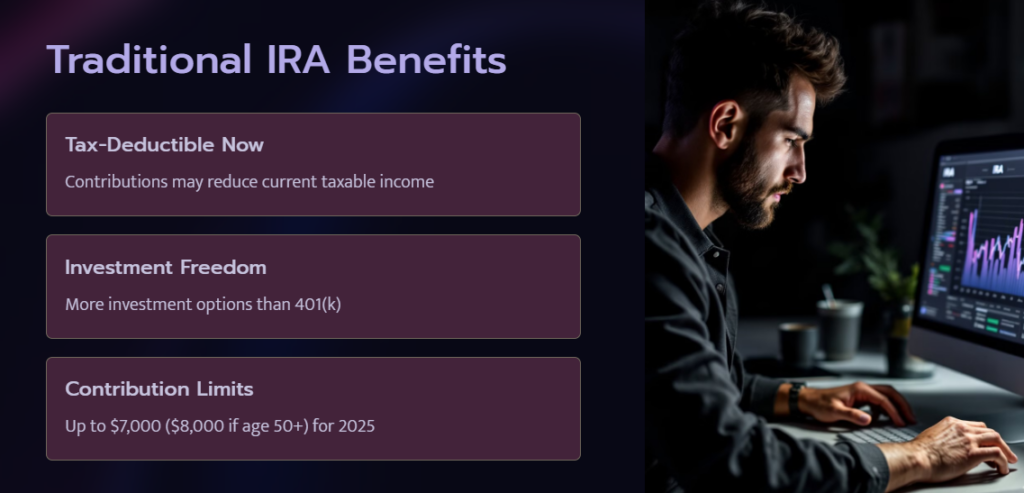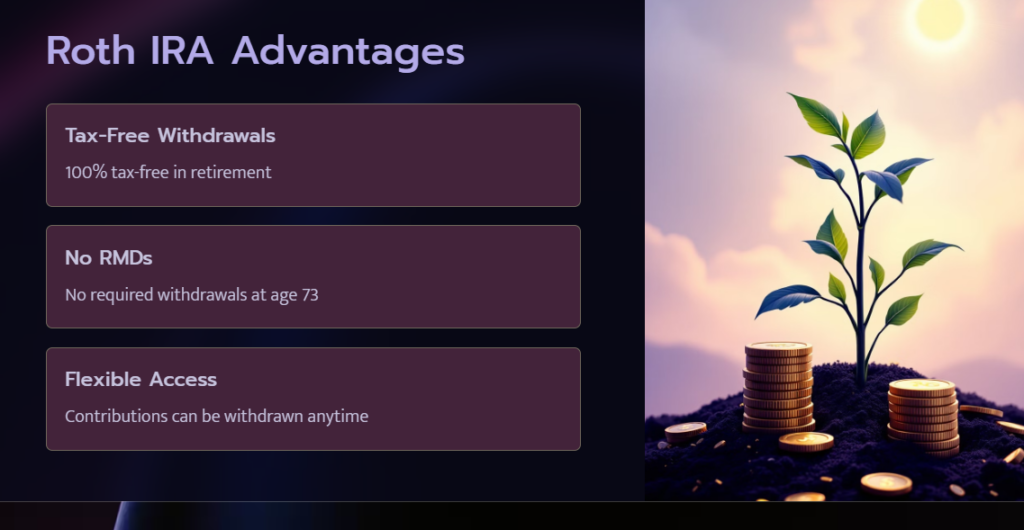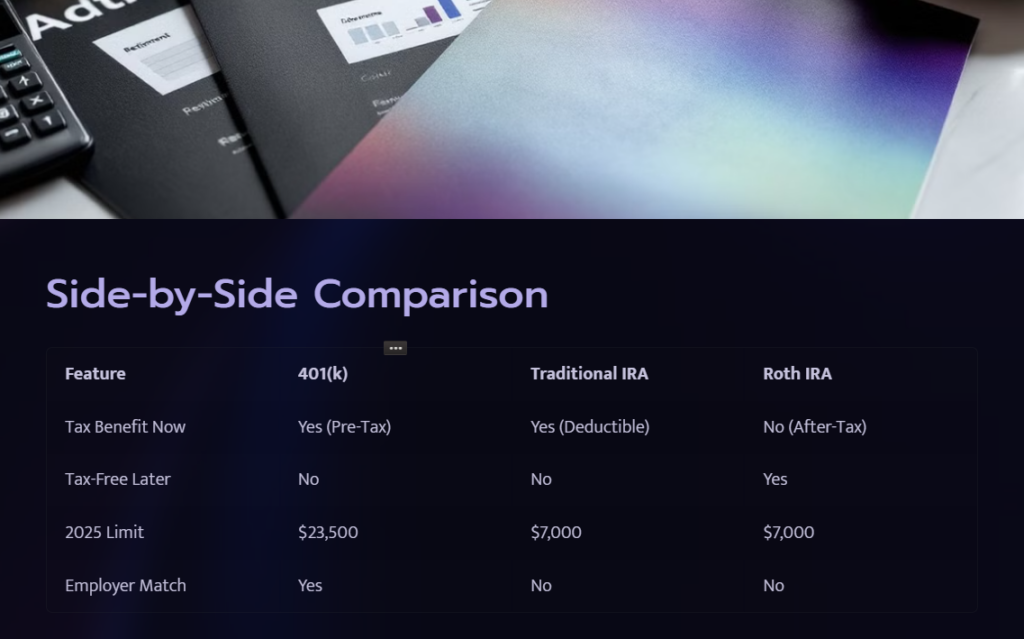Saving for retirement is one of the most important financial decisions you’ll make. But with different retirement plans available, choosing the best option for tax savings can be confusing. Should you go with a 401(k), Traditional IRA, or Roth IRA?
In this guide, we’ll break down how each plan works, their tax benefits, and which retirement plan might be best for you based on your financial situation.
Understanding the Basics of Retirement Plans
1️⃣ 401(k) – Best for Employer Contributions & High Earners
A 401(k) is an employer-sponsored retirement plan that allows employees to contribute pre-tax income, reducing taxable income for the year. Many employers match a percentage of your contributions, providing free money for your retirement.
✔ Tax Benefits: Contributions reduce taxable income, and money grows tax-deferred until withdrawal.
✔ 2025 Contribution Limit: Up to $23,500 ($31,000 if age 50+)
✔ Employer Match: Many employers match 3-6% of salary—this is free money!
✔ Required Minimum Distributions (RMDs): Must begin at age 73
✔ Early Withdrawal Penalty: 10% if withdrawn before age 59½, unless exceptions apply
📌 Best For:
✅ Employees with employer matching contributions
✅ High earners looking to reduce taxable income
✅ Those who want higher contribution limits than IRAs
📌 Tip Always contribute enough to get the full employer match—otherwise, you’re leaving free money on the table!

2️⃣ Traditional IRA – Best for Tax Deductions Now
A Traditional IRA (Individual Retirement Account) is a tax-advantaged account you can open independently, regardless of your employment status. Contributions may be tax-deductible, and your investments grow tax-deferred until withdrawal.
✔ Tax Benefits: Contributions may be tax-deductible, reducing taxable income now.
✔ 2025 Contribution Limit: Up to $7,000 ($8,000 if age 50+)
✔ Investment Choices: Offers more investment options than a 401(k).
✔ RMDs Required: Must begin at age 73
✔ Early Withdrawal Penalty: 10% if withdrawn before age 59½, unless exceptions apply
📌 Best For:
✅ Those who don’t have access to a 401(k) through work
✅ Self-employed individuals looking for tax-deductible contributions
✅ People expecting to be in a lower tax bracket in retirement
📌 Tip: If your income is too high, you may not be able to deduct Traditional IRA contributions.

3️⃣ Roth IRA – Best for Tax-Free Withdrawals Later
A Roth IRA is similar to a Traditional IRA but with a key tax difference—you contribute after-tax dollars, meaning withdrawals in retirement are 100% tax-free.
✔ Tax Benefits: Contributions aren’t deductible, but withdrawals (including earnings!) are tax-free in retirement.
✔ 2025 Contribution Limit: Up to $7,000 ($8,000 if age 50+)
✔ No RMDs: Unlike a Traditional IRA or 401(k), there are no required withdrawals at age 73.
✔ Early Withdrawal Perks: Contributions can be withdrawn anytime tax-free (earnings may be taxed).
✔ Income Limitations: Not available to high earners—phase-out begins at $150,000 for single filers or $230,000 for joint filers in 2025.
📌 Best For:
✅ Young professionals expecting to be in a higher tax bracket in retirement
✅ Those who want tax-free income in retirement
✅ Anyone who doesn’t need immediate tax deductions
📌 Tip: If you make too much to contribute directly to a Roth IRA, consider a Backdoor Roth IRA conversion!

🧠 Want better brain health in retirement? Understanding your retirement account options is a great first step.
Side-by-Side Comparison of 401(k), Traditional IRA, and Roth IRA
| Feature | 401(k) | Traditional IRA | Roth IRA |
|---|---|---|---|
| Tax Benefit Now? | ✅ Yes (Pre-Tax) | ✅ Yes (Deductible) | ❌ No (After-Tax) |
| Tax-Free Withdrawals Later? | ❌ No | ❌ No | ✅ Yes |
| Contribution Limit (2025) | $23,500 ($31,000 if 50+) | $7,000 ($8,000 if 50+) | $7,000 ($8,000 if 50+) |
| Employer Match? | ✅ Yes | ❌ No | ❌ No |
| RMDs Required? | ✅ Yes (Age 73) | ✅ Yes (Age 73) | ❌ No |
| Income Limits? | ❌ No | ❌ No | ✅ Yes ($150,000 for singles, 236,000 for joint in 2025) |

Which Retirement Plan Is Best for You?
🧑💼 If You Have an Employer Match → 401(k)
Why? You get free money and a higher contribution limit.
💼 If You Want a Tax Deduction Now → Traditional IRA
Why? Contributions may be tax-deductible, lowering taxable income.
🚀 If You Want Tax-Free Withdrawals Later → Roth IRA
Why? No taxes on withdrawals in retirement and no RMDs.
💡 The Ideal Strategy: Use Multiple Accounts!
Many people use a combination of accounts for the best results.
✔ Step 1: Contribute to your 401(k) up to the employer match
✔ Step 2: Fund a Roth IRA for tax-free income later
✔ Step 3: If you have extra savings, max out your 401(k) or Traditional IRA
📌 Example Strategy for a 35-Year-Old Making $80,000/year:
- Contribute 6% ($4,800) to 401(k) to get full employer match
- Max out Roth IRA ($7,000) for tax-free growth
- Invest extra savings into a brokerage account or more into 401(k)
🚀 Take Action on Your Retirement Today!
Choosing the right retirement plan depends on your income, tax situation, and long-term goals.
✔ If you have an employer match, start with a 401(k)
✔ If you want immediate tax savings, a Traditional IRA is great
✔ If you want tax-free withdrawals, a Roth IRA is the best choice
✔ For best results, use a mix of accounts to optimize tax savings!
📌 Next Steps:
💡 Check if your employer offers a 401(k) match & contribute enough to get it!
💡 Open an IRA (Traditional or Roth) to supplement your retirement savings!
💡 Consult a financial advisor if you’re unsure which plan is best for you.

💬 Which retirement plan are you using? Drop a comment below!
📌 Check out our full guide:
- How to Maximize Tax Benefits If You’re Self-Employed
- Who Qualifies Child Tax Credit(CTC) & Earned Income Tax Credit (EITC) in 2025?
- Tax Deadline 2025: Everything You Need to Know to File on Time
- Maximize Your Tax Refund: Last-Minute Filing Tips for 2025


